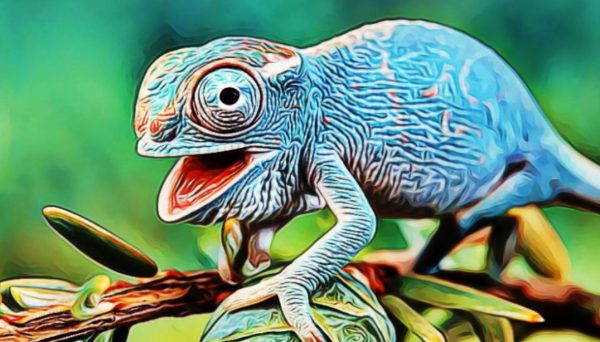10 characteristics of REPTILES
12 months ago
Reptiles are cold-blooded animals. Most reptiles lay eggs, and their skin is covered with hard, dry scales. Cold-blooded animals do not automatically maintain a constant body temperature. They have to lie in the sun to keep their bodies warm. This also means that reptiles don't burn as much energy to keep their bodies warm, and as a result don't have to eat as much food as a similarly sized mammal or other warm-blooded animals.
There are many types of reptiles. The main categories are snakes, crocodiles and alligators, turtles and lizards. Reptiles can be found on every continent except Antarctica.

Reptile Characteristics
- Reptiles are four-legged vertebrate animals.: All reptiles are tetrapods, which simply means that they have four limbs (like turtles and crocodiles) or that they are descended from four-limbed animals (like snakes). More generally, reptiles are vertebrate animals, meaning that they have backbones, which house the backbones, that extend the length of their bodies, a characteristic they share with birds, fish, mammals, and amphibians. In evolutionary terms, reptiles are intermediate between amphibians (which have moist skin and need to stay near bodies of water) and mammals (which have warm-blooded metabolisms and have diversified in every habitat on earth).
- Most reptiles lay eggs.: Reptiles are amnion animals, which means that the eggs, laid by the females, contain an elastic sac within which the embryo develops. Most reptiles are oviparous, laying hard-shelled eggs, but some scaly lizards are viviparous, giving birth to live young that develop inside the bodies of females. You may be under the impression that only mammals are viviparous, but this is not true; Not only some reptiles give birth to live young, but also certain species of fish! Most reptiles differ from mammals in that they lack placentas, the tissue structure that nourishes developing embryos inside the womb.
- Reptile skin is covered with scales.Developing from the epidermis (the outermost layer of skin), reptile scales are small, hard plates made of the protein keratin. Scutes, like the shells of turtles and the armor of crocodiles, are similar in appearance and function to scales, but are bony structures that form in a deeper layer of skin, the dermis. Scales and scutes provide physical protection for reptiles and also prevent water loss; in many species the shapes and colors of these structures play a role in territorial disputes and courtship displays. Note that although all reptiles have scales, this is not a unique feature of the reptile; Butterflies, birds, pangolins, and fish also have scales.
- Reptiles have three-chambered hearts.: except alligators and crocodiles that have four-chambered hearts. They have two aortic blood vessels that carry blood from the heart to all other parts of the body. Well-developed lungs that fold into small sacs called alveoli help reptiles to breathe. All reptiles breathe through their lungs throughout their lives. These alveoli greatly increase the internal surface area and increase the effectiveness of the lungs.
- Possess metanephic kidneys: Reptiles also possess metanephric kidneys, twelve pairs of cranial nerves, at least two spinal bones, a ball-and-socket connection.
- His tongue It has very important functions in your life: taste, smell and touch. There are species that have areas capable of detecting infrared and/or thermal radiation.
- Your vision is essential: Regarding the sensory organs, reptiles rely on their vision more than any other sensory organ, except snakes which are blind. Reptiles use their vision to detect objects around their environment. All reptiles lack external ears, instead having an eardrum that sits clear of the eyes and sits close to the surface of the skin.
- Reptiles have cold-blooded metabolisms: The body temperature of cold-blooded animals is determined by the temperature of their environment; This is in contrast to warm-blooded animals, whose body temperature is maintained within a small, constant range, largely independent of external conditions. Because they are cold-blooded or ectothermic, reptiles must bask in the sun to increase their internal body temperature, which in turn allows for a higher level of activity (as a rule, warm lizards run faster than cool lizards). When they overheat, reptiles seek shelter in the shade to cool down again to a safer temperature, and at night many species are virtually immobile.
- Reptiles breathe with the help of their lungs.: One of the most important characteristics of animals is the efficiency with which they collect and use oxygen, the molecular fuel that powers metabolic processes. All reptiles, including snakes, turtles, crocodiles, and lizards, are equipped with air-breathing lungs, although different types of reptiles employ different means of respiration. For example, lizards breathe using the same muscles that they run, meaning they have to hold their breath while moving, while crocodiles have more flexible diaphragms that allow for greater freedom of movement. As a general rule, the lungs of reptiles are more advanced than those of amphibians, but less sophisticated than those of birds and mammals.
- Reptiles lack the secondary palate: that allows breathing while chewing and swallowing. With exception, crocodiles have a bony secondary palate and turtles have a partial secondary palate.
📂 Citar artículo
ENCICLOPEDIA DE CARACTERÍSTICAS (2024) 10 characteristics of REPTILES, en 10caracteristicas.com. https://10caracteristicas.com/en/10-characteristics-of-reptiles/ (Consultado el: 20-05-2024)
🌐 Enlazar artículo
📌 Enlace corto a esta página:
https://10caracteristicas.com/?p=2437
📑 Impresión del artículo
Imprimir publicación
¿Quieres leer más artículos similares a: 10 characteristics of REPTILES (Actualizado 2024)? Puedes visitar la categoría Pets and animals para ver más contenido relacionado.
